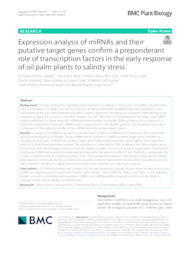Expression analysis of miRNAs and their putative target genes confirm a preponderant role of transcription factors in the early response of oil palm plants to salinity stress.
Expression analysis of miRNAs and their putative target genes confirm a preponderant role of transcription factors in the early response of oil palm plants to salinity stress.
Autoria: SALGADO, F. F.; VIEIRA, L. R.; SILVA, V. N. B.; LEAO, A. P.; GRYNBERG, P.; COSTA, M. M. do C.; TOGAWA, R. C.; SOUSA, C. A. F. de; SOUZA JUNIOR, M. T.
Resumo: Several mechanisms regulating gene expression contribute to restore and reestablish cellular homeostasis so that plants can adapt and survive in adverse situations. MicroRNAs (miRNAs) play roles important in the transcriptional and post-transcriptional regulation of gene expression, emerging as a regulatory molecule key in the responses to plant stress, such as cold, heat, drought, and salt. This work is a comprehensive and large-scale miRNA analysis performed to characterize the miRNA population present in oil palm (Elaeis guineensis Jacq.) exposed to a high level of salt stress, to identify miRNA-putative target genes in the oil palm genome, and to perform an in silico comparison of the expression profile of the miRNAs and their putative target genes. Several mechanisms regulating gene expression contribute to restore and reestablish cellular homeostasis so that plants can adapt and survive in adverse situations. MicroRNAs (miRNAs) play roles important in the transcriptional and post-transcriptional regulation of gene expression, emerging as a regulatory molecule key in the responses to plant stress, such as cold, heat, drought, and salt. This work is a comprehensive and large-scale miRNA analysis performed to characterize the miRNA population present in oil palm (Elaeis guineensis Jacq.) exposed to a high level of salt stress, to identify miRNA-putative target genes in the oil palm genome, and to perform an in silico comparison of the expression profile of the miRNAs and their putative target genes. Our findings provide new insights into the early response of young oil palm plants to salinity stress and confirm an expected preponderant role of transcription factors - such as NF-YA3, HOX32, and GRF1 - in this response. Besides, it points out potential salt-responsive miRNAs and miRNA-putative target genes that one can utilize to develop oil palm plants tolerant to salinity stress.
Ano de publicação: 2021
Tipo de publicação: Artigo de periódico
Unidade: Embrapa Agroenergia
Observações
1 - Por padrão são exibidas publicações dos últimos 20 anos. Para encontrar publicações mais antigas, configure o filtro ano de publicação, colocando o ano a partir do qual você deseja encontrar publicações. O filtro está na coluna da esquerda na busca acima.
2 - Para ler algumas publicações da Embrapa (apenas as que estão em formato ePub), é necessário ter, no celular ou computador, um desses softwares gratuitos. Sistemas Android: Google Play Livros; IOS: iBooks; Windows e Linux: software Calibre.
Acesse outras publicações
Acesse a Base de Dados da Pesquisa Agropecuária (BDPA) para consultar o acervo completo das bibliotecas da Embrapa.

